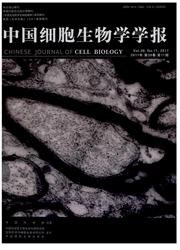

 中文摘要:
中文摘要:
目的:探讨不同温度对麻醉后小鼠晶状体出现突发性浑浊的影响。方法:用10%水合氯醛(400础啦g)腹腔注射麻醉40只雄性C57/BL6小鼠,分别置于4℃、15℃、23℃、37℃,扩瞳后,于麻醉后10min、20min、30min、45min、60min裂隙灯观察小鼠晶状体浑浊状态,60min后小鼠断颈处死,冰冻切片行HE染色检测晶状体形态学改变。结果:麻醉后,4℃下所有小鼠在麻醉10min后出现晶状体浑浊,15℃中8只小鼠在麻醉10min后开始出现晶状体浑浊,60min后全部小鼠晶状体浑浊,在23℃中1只小鼠在麻醉10min后开始出现晶状体浑浊,60min后8只小鼠晶状体浑浊,37℃中,麻醉20min后才开始出现晶状体浑浊,60min后,共5只出现晶状体浑浊。HE染色显示晶状体重度浑浊时,晶状体前膜囊增厚,上皮细胞增多,排列紊乱,层次增多。结论:低温可诱导麻醉后小鼠晶状体更早出现浑浊,并使浑浊程度加重,在进行晶状体等眼科相关动物实验中,麻醉后应注意给小鼠保温,避免出现严重的晶状体浑浊,干扰实验结果。
 英文摘要:
英文摘要:
Objective: To explore the influence of different temperature on lens opacification of anaesthetized mice. Methods: The 40 male C57/BL6 mice were anesthetized with intraperitoneal injections of 10% chloral hydrate ( 400mg/kg ) and then exposed to 4℃, 15℃, 23℃, and 37℃. Lens opaciflcation was examined with a slit lamp at 10min, 20min, 30min, 45min, 60min respectively after my-driasis, then mice were dislocated the neck to death at 60 minutes after anesthetized, the HE staining was observed in lens with frozen sections. Results: All mice showed lens opacification at 10 min after anesthesia exposure to 4℃; 8 mice showed lens opacification at 10 min and all mice showed lens opacification at 60min after anesthesia exposure to 15℃; 1 mice showed lens opacification at 10 min and 8 mice showed lens opaciflcation at 60min after anesthesia exposure to 23℃; the lens began to appear opacification at 20min and then 5 mice showed lens opacification at 60min after anesthesia exposure to 37℃. HE staining showed that the lens anterior capsules were thickened and the epithelial cells increased and arrangement disorder when lens with servere opacification. Conclusions: Low tempera- ture may induce a earlier time of lens opacification appeared, and a heavier turbidity significantly increases cataract formation in anes-thetized mice. In order to avoid servere lens opacification and interference with the experimental results, it is better to pay attention to keep the mice warm after anesthesia when in the lens and related animal experiments.
 同期刊论文项目
同期刊论文项目
 同项目期刊论文
同项目期刊论文
 The correlation between rat retinal nerve fiber layer thickness around optic disc by using optical c
The correlation between rat retinal nerve fiber layer thickness around optic disc by using optical c Differential neuronal expression of receptor interacting protein 3 in rat retina: involvement in isc
Differential neuronal expression of receptor interacting protein 3 in rat retina: involvement in isc 期刊信息
期刊信息
